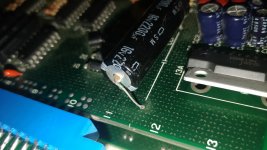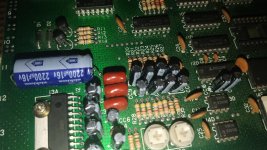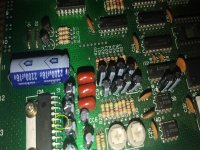LittleLarrySellers
Professional
Well, this is my first major fail in the hobby. So I picked up a dead GnG board for cheap on eBay. I wouldn't mind a backup to my working board and figured it could be fun to try and fix.
The board had some of the ROMs missing and the PROM and someone absconded with the sound amp (HA13001). Otherwise, was just some corrosion on the solder sides.
When the board arrived I cleaned up the corrosion and then tried moving my ROMs/PROM from my working board to the dead one and see what happens. To my surprise, the board powered on and I was able to coin up! There are some sprite issues with Arthur and the joystick UP wasn't registering and obviously no sound. Otherwise, huge progress from DOA!
I put aside the joystick and sprite issues to tackle the sound first. I ordered a HA13001 and soldered it on and bingo I had sound. I noticed though the sound of Arthur's weapon and the impact noise on tombstones was missing. I couldn't decipher anything from the schematics for the sound section so I looked at the caps and noticed the big axial one in the sound area seemed to have started to leak as you can see in the pic.
Here is where EVERYTHING went to shit.
I ordered a 2200uf 25V cap to replace it b/c my understanding is the voltage is just an upper bound and should be ok to use higher rated ones (right?). After I soldered it in (polarity was correct) the board died. Like it is totally fubar now. I can't get stable power to the board. My minigun would usually display the 5V on the voltmeter and the green light would be on my PSU (RT-65A). Now, there is no 5V reading and my power supply has no green light and just makes a clicking noise. I assume short circuit security protection kicking in. Somehow after replacing that one cap the board seems to have shorted so I can't even get it to power on
Here is what I have done with no success:
Basically, I had a board that was on the road to working and is now a giant 35 year old paperweight. FML. I don't know how replacing that one cap caused the board to crap out. Can I create a short to ground from the via? I have recapped stuff before and never had an issue like this.
I also don't know how to debug this further now. I read something about cutting traces which you can't do with GnG and not sure I even would if I could. I also saw some YouTube videos about using diode mode on my working board vs. the dead board chip by chip, pin by pin find where the resistance drops substantially as a way to find the culprit. Is this the best approach? Any other suggestions would be appreciated. Really bummed by this turn of events.
The board had some of the ROMs missing and the PROM and someone absconded with the sound amp (HA13001). Otherwise, was just some corrosion on the solder sides.
When the board arrived I cleaned up the corrosion and then tried moving my ROMs/PROM from my working board to the dead one and see what happens. To my surprise, the board powered on and I was able to coin up! There are some sprite issues with Arthur and the joystick UP wasn't registering and obviously no sound. Otherwise, huge progress from DOA!
I put aside the joystick and sprite issues to tackle the sound first. I ordered a HA13001 and soldered it on and bingo I had sound. I noticed though the sound of Arthur's weapon and the impact noise on tombstones was missing. I couldn't decipher anything from the schematics for the sound section so I looked at the caps and noticed the big axial one in the sound area seemed to have started to leak as you can see in the pic.
Here is where EVERYTHING went to shit.
I ordered a 2200uf 25V cap to replace it b/c my understanding is the voltage is just an upper bound and should be ok to use higher rated ones (right?). After I soldered it in (polarity was correct) the board died. Like it is totally fubar now. I can't get stable power to the board. My minigun would usually display the 5V on the voltmeter and the green light would be on my PSU (RT-65A). Now, there is no 5V reading and my power supply has no green light and just makes a clicking noise. I assume short circuit security protection kicking in. Somehow after replacing that one cap the board seems to have shorted so I can't even get it to power on

Here is what I have done with no success:
- I have tried doing a shotgun replacement of all the other caps.
- I have verified if I just send 12V the board will power on stably, so it is 5V.
- I have removed the bottom board and am just trying to get the main PCB to power on.
- I even replaced the 2200uf 25V with a 16V cap like it originally had just in case that somehow did it.
- I desoldered the HA13001 and tried in case that was the culprit and then soldered back, either way fubar.
Basically, I had a board that was on the road to working and is now a giant 35 year old paperweight. FML. I don't know how replacing that one cap caused the board to crap out. Can I create a short to ground from the via? I have recapped stuff before and never had an issue like this.
I also don't know how to debug this further now. I read something about cutting traces which you can't do with GnG and not sure I even would if I could. I also saw some YouTube videos about using diode mode on my working board vs. the dead board chip by chip, pin by pin find where the resistance drops substantially as a way to find the culprit. Is this the best approach? Any other suggestions would be appreciated. Really bummed by this turn of events.




 Hopefully I can work toward actually fixing it now instead of making it worse.
Hopefully I can work toward actually fixing it now instead of making it worse.